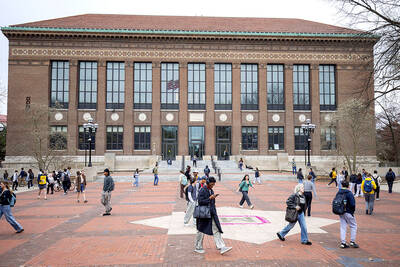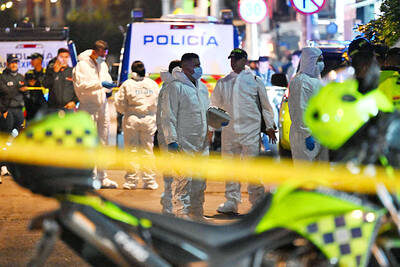Archeologists in Israel said that they have discovered the remnants of an early mosque — believed to date to about 670 — during an excavation in Tiberias.
This mosque’s foundations, excavated just south of the Sea of Galilee by the Hebrew University of Jerusalem, point to its construction roughly a generation after the death of the Prophet Mohammed, making it one of the earliest Muslim houses of worship to be studied by archeologists.
“We know about many early mosques that were founded right in the beginning of the Islamic period,” said Katia Cytryn-Silverman, a specialist in Islamic archeology at Hebrew University who heads the dig.

Photo: AP
Other mosques dating from about the same time, such as the Prophet’s Mosque in Medina, the Great Mosque of Damascus and Jerusalem’s al-Aqsa mosque, are still in use today and cannot be tampered with by archeologists.
Cytryn-Silverman said that excavating the Tiberian mosque allows a rare chance to study the architecture of Muslim prayer houses in their infancy and indicates a tolerance for other faiths by early Islamic leaders.
She announced the findings this month in a virtual conference.
TIBERIAS’ HISTORY
When the mosque was built, Tiberias had been a Muslim-ruled city for a few decades. Named after Rome’s second emperor in about 20, the city was a major center of Jewish life and scholarship for nearly five centuries. Before its conquest by Muslim armies in 635, the Byzantine city was home to one of a constellation of Christian sites dotting the Sea of Galilee’s shoreline.
Under Muslim rule, Tiberias became a provincial capital in the early Islamic empire and grew in prominence. Early caliphs built palaces on its outskirts along the lake shore.
However, until recently, little was known about the city’s early Muslim past.
Gideon Avni, chief archeologist with the Israel Antiquities Authority, who was not involved in the excavation, said that the discovery helps resolve an academic debate about when mosques began standardizing their design, facing toward Mecca.
‘RARE FIND’
“In the archeological finds, it was very rare to find early mosques,” Avni said.
Archeological digs near Tiberias have proceeded in fits and starts for the past century. In recent decades the ancient city has started yielding other monumental buildings from its past, including a sizeable Roman theater overlooking the water and a Byzantine church.
Since early last year, the COVID-19 pandemic halted excavations, and lush Galilean grasses, herbs and weeds have grown over the ruins.
Hebrew University and its partner, the German Protestant Institute of Archaeology, plan to restart the dig next month.
Initial excavations of the site in the 1950s led academics to believe that the building was a Byzantine marketplace later used as a mosque.
However, Cytryn-Silverman’s excavations delved deeper beneath the floor.
Coins and ceramics nestled among at the base of the crudely crafted foundations helped date them to 660 to 680, barely a generation after the city’s capture.
The building’s dimensions, pillared floor-plan and qiblah, or prayer niche, closely paralleled other mosques from the period.
MYSTERY
Avni said that for a long time, academics were not sure what happened to cities in the Levant and Mesopotamia conquered by the Muslims in the early seventh century.
“Earlier opinions said that there was a process of conquest, destruction and devastation,” he said.
Today, archeologists understand that there was a “fairly gradual process, and in Tiberias you see that,” he said.

A Chinese scientist was arrested while arriving in the US at Detroit airport, the second case in days involving the alleged smuggling of biological material, authorities said on Monday. The scientist is accused of shipping biological material months ago to staff at a laboratory at the University of Michigan. The FBI, in a court filing, described it as material related to certain worms and requires a government permit. “The guidelines for importing biological materials into the US for research purposes are stringent, but clear, and actions like this undermine the legitimate work of other visiting scholars,” said John Nowak, who leads field

Swedish campaigner Greta Thunberg was deported from Israel yesterday, the Israeli Ministry of Foreign Affairs said, the day after the Israeli navy prevented her and a group of fellow pro-Palestinian activists from sailing to Gaza. Thunberg, 22, was put on a flight to France, the ministry said, adding that she would travel on to Sweden from there. Three other people who had been aboard the charity vessel also agreed to immediate repatriation. Eight other crew members are contesting their deportation order, Israeli rights group Adalah, which advised them, said in a statement. They are being held at a detention center ahead of a

‘THE RED LINE’: Colombian President Gustavo Petro promised a thorough probe into the attack on the senator, who had announced his presidential bid in March Colombian Senator Miguel Uribe Turbay, a possible candidate in the country’s presidential election next year, was shot and wounded at a campaign rally in Bogota on Saturday, authorities said. His conservative Democratic Center party released a statement calling it “an unacceptable act of violence.” The attack took place in a park in the Fontibon neighborhood when armed assailants shot him from behind, said the right-wing Democratic Center, which was the party of former Colombian president Alvaro Uribe. The men are not related. Images circulating on social media showed Uribe Turbay, 39, covered in blood being held by several people. The Santa Fe Foundation

NUCLEAR WARNING: Elites are carelessly fomenting fear and tensions between nuclear powers, perhaps because they have access to shelters, Tulsi Gabbard said After a trip to Hiroshima, US Director of National Intelligence Tulsi Gabbard on Tuesday warned that “warmongers” were pushing the world to the brink of nuclear war. Gabbard did not specify her concerns. Gabbard posted on social media a video of grisly footage from the world’s first nuclear attack and of her staring reflectively at the Hiroshima Peace Memorial. On Aug. 6, 1945, the US obliterated Hiroshima, killing 140,000 people in the explosion and by the end of the year from the uranium bomb’s effects. Three days later, a US plane dropped a plutonium bomb on Nagasaki, leaving abut 74,000 people dead by the